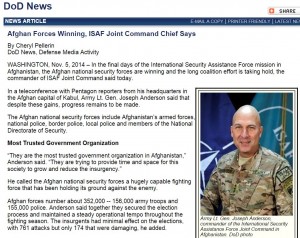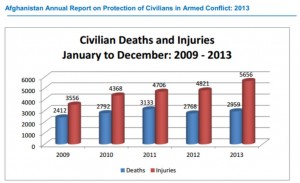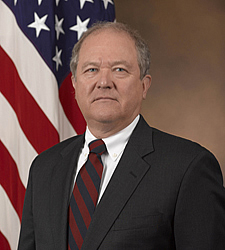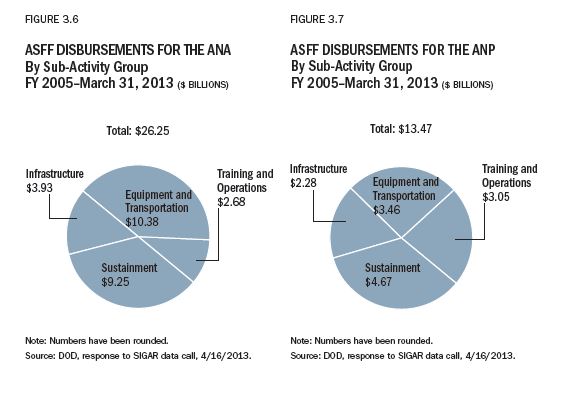Did Obama Order Total Information Shutdown on Afghanistan?
In a stunning and blatantly obvious move to try to hide its failed efforts in Afghanistan, the military suddenly decided back in October that they would classify any and all information on the capabilities of Afghan National Security Forces (ANSF) despite data having been provided to the Special Inspector General for Afghanistan Reconstruction (SIGAR) for the 24 quarterly reports that preceded the one dated October 30, 2014 (pdf). Initial digging on that classification decision appeared to put the classification decision in the hands of ISAF Joint Command. The head of ISAF Joint Command then broke his own classification of ANSF capability a few days later when he proclaimed that ANSF is a “hugely capable fighting force” in a news briefing.
The timing for this classification couldn’t have been worse. US forces were in the final stages of the handoff of Afghan security to ANSF and Barack Obama eventually relied on butchered semantics to proudly proclaim that the war was over, despite a residual fighting force to which he had secretly given expanded combat powers.
Today, though, the classification of ANSF capability last quarter looks less like an arbitrary move by the Commander of ISAF Joint Command and more like a total information shutdown on Afghanistan. Perhaps Lt. Gen. Anderson just got the call for a shutdown before everyone else. In the SIGAR quarterly report released today (pdf), we learn that the military now has classified “nearly every piece of data used by the inspector general to assess the Afghan security forces.” In an appendix to the report, SIGAR lists the more than 140 questions that the military previously responded to openly but now says the answers are classified. Here is a sampling that SIGAR provided in the email sent out releasing the report:
–The over 140 SIGAR questions that received classified or otherwise restricted responses are listed starting on page 211. Sample of questions:
–Please provide a broad definition of the terms “unavailable” and “present for duty.” (page 211)
–Total amount of funding that the United States has expended on Afghan National Army food from Afghan Security Forces Fund (ASFF) for the current year. (page 211)
–How has the $25 million authorized by Congress for women in the Afghan army been used? (page 212)
–Total amount of funding that the United States has expended on Afghan National Police salaries from ASFF for the current year. (page 212)
–Please provide details of DOD/NATO-funded contracts to provide literacy training to the ANSF, including: a. the cost of the contract(s) and estimated cost(s) to complete (page 213)
–Please confirm that the Combined Joint Interagency Task Force-Afghanistan (CJIATF-A) is dissolved. (page 215)
–Please offer an assessment of the anticorruption initiatives of Afghan Ministry of Defense and Afghan Ministry of Interior (page 215)
As the New York Times article linked above points out, the military also initially tried to classify the number of US forces present in Afghanistan and only relented on that point when it was pointed out that the number had already been released by the Obama Administration.
The “explanation” offered by the Commander of US troops in Afghanistan, General John F. Campbell, is far from satisfactory. Here is an excerpt from his letter to SIGAR explaining the sudden expansion of classification:
Campbell then had the temerity to add later in his letter that he is “committed to maximum transparency in our operations”. Just wow. That sounds like Obama declaring himself the most transparent President ever, and then going on to rely on expanded classification coupled with unprecedented levels of prosecution of whistleblowers.
But instead of just looking like a move Obama would make, perhaps it did come at his behest. Not only is the military clamming up on virtually all information out of Afghanistan, it appears that the State Department is as well. From page 147 of SIGAR’s report:
Despite the requirement of Public Law 110-181 that federal agencies provide requested information or assistance to SIGAR, the State Department did not answer any of SIGAR’s questions on economic and social-development this quarter, and failed to respond to SIGAR’s attempts to follow up.
Had only one Federal agency, the Defense Department, suddenly shut down the flow of information, it would have been easy to believe that they were ones trying to hide their own failures. But now that a second agency, the State Department, has shut down information flow at the same time, and won’t even provide an explanation for their move, it seems clear to me that the order to shut down information flow had to come from above. With both the Defense Department and State Department going silent, could such an order have come down from anyone other than Obama himself? The failure that is our Afghanistan war has entered its fourteenth year, has spanned two presidents and is now being summarily swept under the rug by the Most Transparent Administration Ever®.
Postscript: For more evidence on just how failed the Afghanistan effort has been, recall that John Kerry’s brokered extra-constitutional National Unity Government was over three months late in finally announcing a full slate of 19 cabinet nominees. Sadly, the slate included poorly screened candidates and the Afghan Parliament yesterday rejected 10 of those nominees while voting to confirm only 9.







